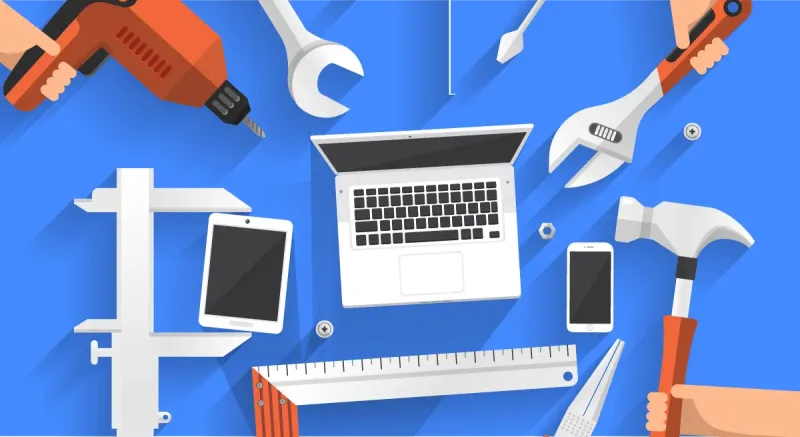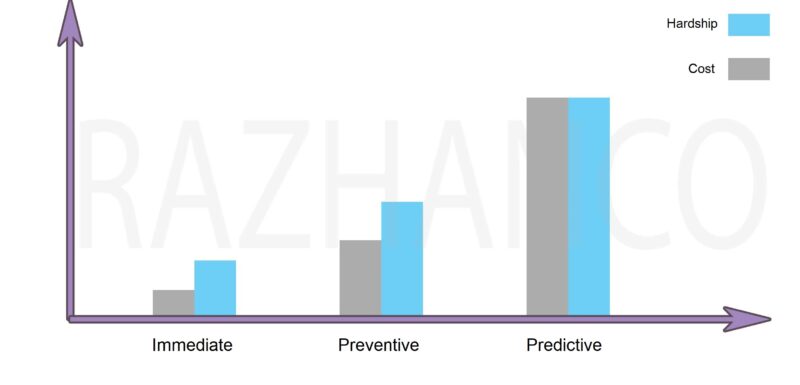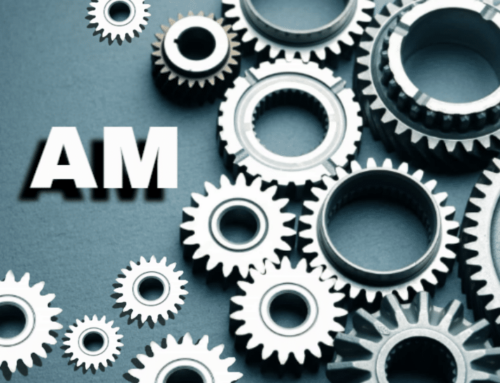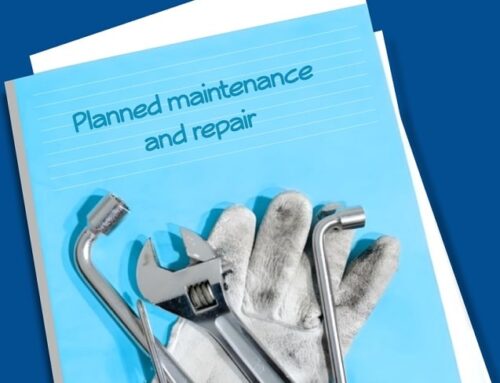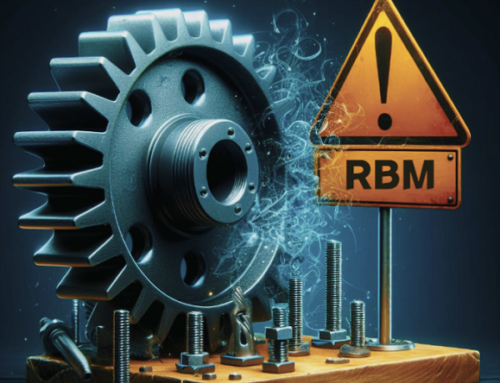Preventive maintenance and repairs (PM)
What you read in this article:
Preventive maintenance and repairs (PM)
Types of preventive maintenance and repairs
Benefits of preventive maintenance and repairs (PM)
Preventive maintenance and repairs reduces the number of unexpected breakdowns
Maintenance provides preventive maintenance and general repairs
Preventive maintenance improves organizational productivity
No piece lasts forever. Constant wear and tear will eventually lead to equipment failure or jeopardizing operating profit.
PM preventive maintenance is a key solution to delay equipment failure and extend the useful life of your assets.
Even though the amount of people’s knowledge about preventive maintenance and repairs has increased compared to the past, many organizations are still hesitant to change from EM to PM. They assume that change will be difficult or expensive and not worth the trouble.
The purpose of this article is to dispel these traditions and show how to implement a preventive maintenance program.
-
What is preventive maintenance and repairs?
Preventive maintenance, abbreviated as PM, is a regular maintenance strategy before equipment failure occurs.
PM was one of the first reactions to increasing maintenance and repair costs. Factory owners realized that investing in maintenance and repairs is more cost-effective than constantly replacing and repairing equipment.
Even where it was cheap to repair or replace the asset, production delays, safety issues, reputational damage, and employee dissatisfaction were reason enough to consider ways to reduce the number of unexpected machine failures.
Over the years, proactive maintenance has proven to be an effective treatment that can be used in any industry that relies on infrastructure and physical assets.
-
Types of preventive maintenance and repairs
There are two types of preventive maintenance and repairs.
As we mentioned earlier, PM are done at regular intervals. These intervals are not chosen arbitrarily, for example, you cannot arbitrarily decide that Thursday is the day of visual inspections or that the oil change is done only on Saturday.
Based on how those intervals are defined, preventive maintenance and repairs can be divided into two groups: maintenance and repairs based on time and maintenance and repairs based on use.
-
Time-based maintenance and repairs
Time-based maintenance and repairs are performed at specific intervals, regardless of the condition and usage of the asset.
Time intervals can be adjusted based on the instructions provided by the equipment manufacturer and personal experience of maintenance and repair technologies, as well as company and regional regulations.
Here are some examples of time-based maintenance and repairs:
-
Change the filter every two months
-
Change the oil every three weeks
-
Testing the fire extinguishing system every six months
The main disadvantage of time-based maintenance and repairs is excessive maintenance and repairs. In other words, performing maintenance and repairs before they are actually needed is a waste of resources that could be better used elsewhere.
One of the ways to solve this problem is to adjust the maintenance and repair calendar based on the data recorded in your CMMS software.
-
Maintenance and repairs based on use
Maintenance and repairs based on use are more accurate than the previous case. We know that the amount of mileage can be obtained from certain parts. In the same way, we can have an accurate estimate of the consumption of resources (oil, fuel, etc.) on average. When you have this data readily available, scheduling based on time is trivial. Now the question arises, why use-based maintenance and repairs do not completely replace time-based maintenance and repairs?
There are several factors. The main reason is the inability to track the use of all assets or track them. For example, you cannot visit a fire engine based on mileage or hours of operation.
You do the best you can with the data you have. If you run CMMS software, you can use it to periodically review maintenance and repair records.
-
Immediate, preventive and predictive maintenance and repairs
It seems that it is very difficult to understand REACTIVE, PREVENTIVE and PREDICTIVE maintenance. They are three common types of maintenance strategies. You can see their relationship in the diagram below:
You can think of predictive maintenance as a more efficient version of PM preventive maintenance, whose work schedule is based on predictive algorithms. These algorithms use data from condition monitoring sensors to predict failure points and help you plan maintenance operations and repairs just before they occur. Both PM and predictive maintenance and repairs prevent failures from occurring instead of repairing them.
EM is the opposite of the previous two strategies. This strategy includes some routine maintenance and repairs, and most of the time is spent dealing with breakdowns.
Each of these strategies has different benefits, challenges, requirements, implementation costs, and potential ROI that we will highlight in future articles…
-
Benefits of preventive maintenance and repairs (PM)
Preventive maintenance and repairs has several benefits. Here are some interesting stats to check out:
- The actual cost of unplanned equipment failure, based on the industry and size of the organization, can range from a few hundred Dollars per hour to several million Dollars per hour. PM can minimize the number of costly machine breakdowns.
- The cost of the wrong maintenance can be three to 10 times that of a good maintenance program. In other words, every 1000 Dollars invested in preventive maintenance and repairs can save you 5,000 Dollars on average by avoiding future costs.
In order to get to know more concretely the benefits of preventive maintenance and repairs, we will discuss a cause and effect relationship between performing PM and the resulting benefits.
-
Preventive maintenance and repairs reduces the number of unexpected breakdowns
It’s only natural that cars you care about and maintain regularly are less prone to unexpected breakdowns. PM facilitates this task in two major ways.
The first way is to be sure of basic needs for property maintenance and repairs.
The role of oil and filter is something that even active organizations try to cover, but the problem is that it is usually very regular. Hence, even basic maintenance and repairs are not done on time or are not even included in the backlog list.
The solution to this issue is from PM. Preventive maintenance and repairs forces you to create and adhere to a maintenance calendar.
The second way is planning to inspect and detect signs of failure.
Many maintenance and repairs programs rely on the equipment manufacturer’s instructions to determine maintenance intervals. However, the OEM instructions assume that you have them handled under certain conditions.
In fact, the plant may suffer from things like increased dust levels. You can have inexperienced equipment operators who are abusing and damaging the equipment as a result. You may even cut costs by using cheaper replacement parts. Regular inspections are provided here to cover such scenarios and help you recognize the possibilities as soon as possible. While regular inspections bring tangible results, they can be time-consuming.
-
Maintenance provides preventive maintenance and general repairs
Preventive maintenance and repairs methods can help you reduce your general maintenance and repair costs. Many of these methods are indirect (preventing costly failures), so they are easily overlooked.
Here are the cost savings in general maintenance and repairs by using preventative maintenance:
-
Extending asset life:
With preventive maintenance and repairs, unexpected breakdowns rarely occur without serious damage to equipment, which increases the useful life of your assets.
-
Reducing spare parts inventory costs:
Without maintenance and repairs, you must have a large number of spare parts in stock or use transportation for emergency supply of parts.
PM provides you with the level of stability of the equipment and helps you to have a more accurate forecast of the inventory of the goods, to the special management supported by the maintenance and repairs software with the inventory module.
-
Reducing labor costs:
Instant maintenance and repairs inevitably become overtime. Overtime increases labor costs. Over time, a preventive maintenance and repairs program should reduce overtime to a minimum.
-
Optimum performance and work safety:
Previously, systems should be tested from time to time to ensure optimal performance. Assets that fail unexpectedly can be a safety hazard. Many times, the reason for these incidents is negligence, and preventive maintenance and repairs should be used to prevent such incidents.
-
Preventive maintenance improves organizational productivity
Depending on a critical feature of your workflow, equipment problems can range from minor problems to a complete shutdown of the production process. In a highly optimized production line, if one of the assets is not working well, it will cause downtime and productivity problems.
-
What factors should be considered in order to choose between corrective maintenance and repairs and preventive maintenance and repairs?
- Costs: It is very important to consider the costs related to both methods, including the costs of corrective repairs after the failure and the costs of preventive repairs before the failure. The costs of corrective repairs after failure may be higher than the costs of preventive repairs. In this case, using preventive maintenance and repairs can be more cost-effective.
- Useful life: checking the useful life of equipment and facilities can be useful in decision making. If the equipment is old and nearing the end of its useful life, focusing on corrective maintenance and repairs may be the best way to go. But if the equipment is still in its useful life, preventive maintenance and repairs are appropriate to maintain better and long-term performance of the equipment.
- Significance and impact of failure: In some cases, the failure of an equipment can have a serious impact on the performance or safety of the system. In this case, the use of preventive maintenance and repairs is recommended to prevent breakdowns and ensure the optimal performance of the equipment.
- Working conditions: The environment and working conditions also have an effect on determining the type of maintenance and repairs. In some cases, harsh environments and heavy working conditions may cause increased breakdowns and the need for preventive maintenance and repairs.
- Supply of parts and equipment: checking the inventory of parts and equipment needed for corrective and preventive repairs is important. If parts and equipment are not readily available, corrective repairs after a breakdown may be more difficult and time-consuming. In this case, preventive maintenance can be the best option.
- Impact of equipment downtime: It is also very important to examine the impact of equipment downtime on the processes and overall performance of the organization. If stopping the equipment for corrective maintenance will stop the main activities of the organization and will result in large operating costs and a drop in performance, preventive maintenance and repairs will be the best solution.
- Experience and Expertise: The ability and experience of the maintenance team should also be considered. If the maintenance team has sufficient expertise and experience in corrective or preventive maintenance, the best method can be chosen based on their expertise and experience.
- The overall strategy of the organization: the overall strategy of the organization can also play a role in determining the type of maintenance and repairs. Some organizations may focus on prioritizing the longevity of equipment and reducing breakdowns, and as a result, tend to be more prone to preventive maintenance and repairs.
In general, the decision between corrective and preventive maintenance and repairs depends on the above and the specific conditions of each organization and equipment. It is better to check the advantages and disadvantages of each method according to your specific needs and problems and make a decision that optimizes the organization’s performance and costs.
Once again, preventive maintenance and repairs prevents such problems by keeping the asset healthy.
The use of preventive maintenance and PM maintenance is recommended to everyone because this method is confirmed by logical figures and statistics and there are many organizations that are now using this system and they all have a common point of view: they are better off sooner than later. They regret not doing it.
So act today…


